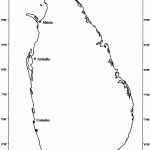Fig 1.1 The sites mentioned in the textRaj Somadeva1 and Sudevi Ranasinghe2
1Senior Lecturer, Postgraduate Institute of Archaeology, Colombo, 2Researcher, Department of Archaeology, Colombo.
Abstract
A rescue excavation conducted in a prehistoric shell-midden identified in the littoral area of southern Sri Lanka had revealed a substantial set of information pertaining to the coastal adaptation of the prehistoric communities in Sri Lanka in c. fourth millennium BC. Seven human skeletons were excavated. The faunal remains associated with the prehistoric levels at the site show a wide range of exploitative selection of the prehistoric subsistence pattern in the dry-arid maritime littoral eco zone of the country. The article presents a preliminary account of the discovery.
Introduction
Cheniers are a distinctive coastal landform appearing in the tropical regions in association with lagoon environments. Morphologically they are low height ridges, which comprise of shell or shelly sand formed on coastal wetlands. The geological characteristics of Cheniers were first described by Russell & Howe (1935) and subsequently the formation processes of this geological feature have been widely discussed (e.g. Chappell & Grindrod, 1984; Augustinius et al., 1989; Anthony, 1989; Zhao, 1989; Short, 1989). The major morphological characteristic of the Cheniers is their association with coastal wetlands of marshy mangroves (e.g. Price, 1955). The low height relief of such formations is well drained and form elevated plains, which separate from the wet and muddy local surroundings. These morphological characteristics had profoundly influenced the habitational choice of the coastal prehistoric groups resulting in a tendency for the appearance of seasonal/temporary prehistoric camps on Chenier ridge surfaces. However these physical characteristics were not the only reason for the attraction of the prehistoric groups to select such locations for occupation and one of the other crucial factors is the abundance of food resources including marine molluscs and seaweeds in the vicinity (Bell, 1981; Hogarth, 1999). Several such prehistoric shell-middens bordering the Indian Ocean waters have been archaeologically examined. A notable example is the case reported from the coast of Oman peninsular that has been dated to the 5th millennium BCE (cleuziou, 2004: 141).
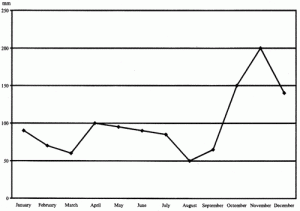
The formation of culturally induced middens on coastal ridges is the result of prehistoric human occupations. Prehistoric shell-middens comprise discarded shells of different shell species together with the residues of other exploitable marine species. The existence of faunal remains of different terrestrial animal species in Pallemalala (see below) may suggest a prevalence of a mixed mode of subsistence strategy perhaps triggered by the environmental constraints. Cyclical droughts are experienced even today in the area and the occurrences of such events have been historically documented as well (Sammohavinodani 316-317).
Exploitation of a wide variety of alternative resources by the prehistoric coastal populations has been reported from different regions in the world (e.g. Minc and Smith, 1989: 11; Hall, 1986: 5).
Pallemalala
Pallemalala is a hamlet situated in the southern littoral area of Sri Lanka (Fig 1.1). Administratively it belongs to the Hambantota district of the Southern province. The annual climatic regime of the area is severely dry and arid signified by the mean annual rainfall of < 1000 mm. The annual temperature variations of the area are outlined below (Fig. 1.2 & 1.3).
The present hamlet lies about 1.5 km north of the sea in the landward direction. At some places between the sea and presently inhabited area, several patchy pockets of lagoons are discernible. The most prominent geo-morphological characters of the landscape are those lagoons and the formation of a shell-bed. The shell-bed appearance is a common coastal geoÂmorphological character of the area from Tangalle to Bundala (Fig. 1.4) in southern Sri Lanka. They appear as highly concentrated pockets of shell accumulation and sometime extend up to 4 km towards the landward direction. The formation of these shell-beds has been discussed in-relation to the Holocene marine geological activities. Katupotha has tended to ascribe the formation of these shell-beds with the mid-Holocene high sea-level episodes that was initiated in 6240 BP. It resulted in;’………the bulk of the shell valves of these shell beds have been piled up by exceptional storm wave action on mounds, in lagoons and lake bottoms…..’ (1995: 50).


However the formation of the shell-beds has been broadly considered as a major coastal morphological indicator of the Younger or Older Peron episodes of sea-level fluctuations. In the Pacific region, the Younger Peron beaches of 3m ( msl) has been dated to 49003600 BP (Fairbridge, 1976: 533) while those of similar character in Andaman and Nicobar Islands (Ahmad, 1972: 185) and Maharashtra and Saurashtra of western India have secured parallel dates (Agrawal and Avasia et al., 1973: 15). Deraniyagala (1992: 701) has correlated the 3800 BP date obtained for the final stage of the prehistoric occupation at Matota with the dates of Younger Peron high sea level occurrence. Pallemalala shell-bed of 4.40m ( msl) seems an exception in terms of elevation but the prehistoric occupation there was earlier to that of Matota. According to Deraniyagala, the techno-complex of Matota finds are Mesolithic in character and further evidence suggest a metastasis of Mesolithic occupation along the maritime littoral area of the island. For instance, the dates c. 6660 BP for Kalametiya, c. 5330 BP for Uda Malala 4200-3800 BP for Matota, c. 3270 BP for Karagan Lewaya and c. 2950 BP for Arankallu (Deraniyagala, 1992:692) shows an explicit continuum of the Mesolithic prehistoric occupation in the coastal areas of the island.
The discovery of the prehistoric shell midden in Pallemalala was the result of identification of an assemblage of human skeletal remains which were found during an excavation by a villager who dug the shell deposit for commercial purposes. During the first visit to the site, the team of archaeologists observed a collection of highly fragmented human skeletal remains that was piled up at the site.
Excavation
Due to the insecure nature of the cultural deposit at the site it was decided to launch a rescue excavation. The Postgraduate Institute of Archaeology in Colombo made arrangement to conduct a salvage excavation at the site under the permission of the Department of Archaeology. Filed-work was carried out by a team headed by the author in a period of 15 days between 27 August and 12 September 1997. An area of 4x 3m of an undisturbed section of the site was excavated. The primary objective of the excavation was to retrieve as much data as possible before the site was completely destroyed. Two units of the prehistoric habitation at the site were unearthed. In unit 1 the settlement floor consisted of a wide scattering of food residues (animal bones) and a grinding stone (Fig. 2.1) along with the evidence of fire. Unit 2 was the burial floor (Fig. 2.2), about 50 cm below unit 1 but no artifacts were reported form this level except 7 human skeletons.
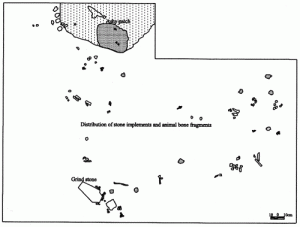
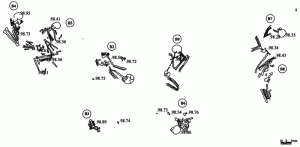
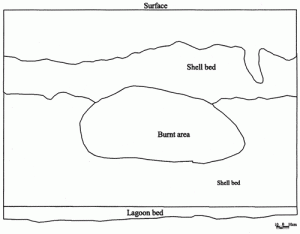
Stratigraphy
Two lithostratigraphic units were observed down to a depth of 1.2 meters from the surface. In the midst of those two, there was the shell deposit feature identified as a Chenier formation (Fig. 3.1). The first lithostratigraphic unit consists of the topsoil layer, which does not exceed 60 cms in thickness. This blackish grey soil has a high percentage of organic matter derived from the continuous leaf-fall. Its formation seems allochathonus. The surface of this layer is inhabited mainly by the scrub jungle vegetation and rarely by stunted trees and grasses. No other bed intrusion was observed within this layer formation. Its cultural content is very low limited to few Black and Red ware potsherds and a fragment of a terracotta bead.
The second lithostratigraphic unit was the bottom layer of the site situated beneath the lower interface of the shell deposit. It was identified as the floor of the ancient lagoon or the marshy tract and was devoid of any cultural material.
The shell deposit
The maximum thickness of the shell deposit observed in the excavated area was approximately 0.7m. At the thickest point, its upper interface is about 60 cm below the surface ( 4.40 msl.). The shell deposit is mixed with a sandy-clay soil extremely hard to excavate. Several burnt patches observed in a cross-section of the shell deposit, suggests that various activities had occurred during different short time-intervals. Some of the charred bone fragments and stone implements scattered in association with these burnt patches compel one to infer that these fire events were culturally induced signatures of the prehistoric human use of that shell deposit.
Majority of the shell species in the deposit are homogenous and belong to the bivalve molluscs family of Pelecypoda. The notable sub-species present in the deposit are Mactra complanata Deshayes (Thin, fragile, rather flat, triangular shell: anterior and posterior margins about equal in length, lower margin regularly arched. White, covered with thin yellowish periostracum) and Mactra turgida Gmelin (Strongly inflated, triangulo-ovate shell covered with thin brownish perio stracum. As this is worn away shell is polished white) (Kirtisinghe,1978:37).
Artifacts
Majority of the artifact are chipped quartz implements and they were deposited together with their waste products. The stone tool assemblage is microlithic in nature including a few varieties of lunates, semi lunates, backed bladelets and bladelet nucleus (Fig. 4.1). A grindstone was also discovered from the habitation floor (Fig. 2.1 above). It has a smooth surface that reflects an intensive use and perhaps it suggests a possible move towards the exploitation of floral resources (e.g. Deraniyagala, 1971:88). However the lack of palaeobotanical remains prevents any further conclusion in this regard.
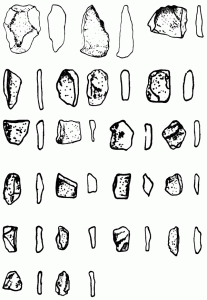
Human skeletons
Seven complete human skeletons have been unearthed with only a single female present in the collection. The collection of fragmented bones (n = 462) unearthed by the illegal diggers, represents 7 individuals including 5 females.
The flexed position of three skeletons is clearly discernible (Fig. 2.2 above) though the position of the rest could not be inferred due to the dispersed nature of the bones. Some of the skeletons were without the skull and it is very difficult to understand whether this was purposely done at the time of the inhumation or it was the result of a post- burial disturbance activity. The ethnographic observations point out that human skulls even today are used in the villages to perform some demonic rituals. However comparisons between these aspects is not possible without in depth study, though it could form a base for an argument.
Anthropometric studies of the skeletal remains suggest that there are three age groups among them ranging between 20yr to over 45yr (20yr / 35-45yr / 45>yr) (Ranaweera, 2002). The Odontometric studies of the stratigraphically excavated skeletons have pointed out that the Trigonid area and the Talonid area percentage (TRA %) of the mandibular molars are smaller than that of the contemporary population but the crown area values of the mandibular molars and the maxillary second molar are large (Peris and Somadeva et al., 2002). In sum, together with other physical attributes of the anatomy, the prehistoric population of Pallemalala could be ascribed to the anthropological genre of the Homo sapiens balangodensis identified and named after the discovery of 12 prehistoric human skeletons from Bellanbandipalassa in Sabaragamuva Province (Deraniyagala, 1958) that is Homo Sapiens sapiens (Kennedy, 1974).
Faunal remains
Besides several shell species a few varieties of fish are also present among the aquatic species. They all are Scombridae species including Euthynnus affinis, and Katsuwonus pelemis which probably characterizes the off-shore fishing. These variety of fishes are abundant during the southwestern monsoon (May to August). With the benefit of this knowledge it can be argued that the seasonal prehistoric camps preferably appeared in the coastal areas of this part of the country during the summer seasons.
Among the identified terrestrial species, except the monkey, the others are (Bubalus bubalus, Cervus unicolor, Axis axis ceylonensis, Sus scrofa cristatus, Tragulus miminna, Herpestes sp, Lessimys punctata, Melanochelys trijuga, Varanas sp.) still-hunted for consumption in the area. Perhaps monkeys would have been hunted for consumption at that time as suggested by the findings from the other prehistoric sites in Sri Lanka (e.g. Deraniyagala, 1992; Adikari and Karunarathne, 1994). According to the observations of the early 20th century ethnographers, the Vadda aboriginal people of the dry zone Sri Lanka were efficient hunters of arboreal species especially monkeys (Seligmann and Seligmann, 1911: 201-2; Spittel, 1961: 31).
Summary
The dates of the site are still being processed. However a temporary timeframe could be established using the Radiometric dates obtained for nearby locations of the same deposit. Two such dates (4050 ± 60 yr. BP un-calibrated, half-life 5568 ± 30, lab no. HR 122 & 4650 ± 70 BP un-calibrated, lab no. HR 268) have been published by Katupotha (1988a; 1988b) and it suggest that the prehistoric occupation here was around 4500 BCE. This range of dates is more or less comparable with that of Matota on the northwestern coast of Sri Lanka (Deraniyagala, 1992). Further northwest of the Indian Ocean, chronometric ally comparable are the dates obtained for the similar shell-midden sites discovered in Oman peninsular such as Ra’s ai-Hamra (RH-5), Wadi Sahab (GAS-1), Ra’s al-Khabbah (KHB-1) and Suwayh (SWY-1). A single radiometric date obtained from an organogenic soil sample from the site at Wadi Sahab (GAS-1) provided a late sixth millennium date (5127 ± 80 un-calibrated Gx-17881) (Ganltier et al. 2005: 19). Wadi Sahab date is closer to the radiometric date (5780 ± 80 un-calibrated, HR 120) assigned for the prehistoric shell midden discovered at Hungama about 30 km west of Pallemalala (Katupotha, 1995).
The data unearthed from the prehistoric site at Pallemalala are limited but it emphasizes the importance of conducting further research focusing upon the coastal adaptation of the prehistoric groups in Sri Lanka.
Acknowledgments
The authors are greatly indebted to Dr. Siran Deraniyagala, former Director General of Archaeology and Dr. Senerath Dissanayake, the Director General of Archaeology for their genial support and encouragement to conduct the excavation and the post-processing work. Thanks should also go to Mr. Oshan Fernando of the Department of Archaeology for his drawings of the stone implements and Mr. Jude Perera for his identifications of the faunal remains. Maps and other computer cartography have been done by Mrs. R. P. Fernando of the GIS unit of the Postgraduate Institute of Archaeology. The excavation was conducted under the funding support of the Postgraduate Institute of Archaeology, Colombo.
References
Adikari, G. and P. Karunarathne. 1994. Excavation at Aligala prehistoric site, in S. Bandaranayake, M. Mogren, S. Epitawatta, eds. Further Studies in the Settlement Archaeology of the Sigiriya-Dambulla Region, Postgraduate Institute of Archaeology, Colombo.
Agrawal, D. P., R. K. Avasia and S. Guzder. 1973. A multidisciplinary approach to the Quaternary problems of Maharashtra, in D. P Agrawal, and A. Gosh, eds. Radiocarbon and Indian Archaeology, Tata Institute, Bombay, pp 3-17.
Ahmad, E. 1972. Coastal Geomorphology of India, Orient Longman, New Delhi.
Anthony, E. J. 1989. Chenier Plain Development in Northern Sierra Leone, Marine Geology 90, West Africa, pp: 297-309.
Augustinius, P. G. E. F. and L. Hazelhoff. 1989. The Chenier Coast of Surinam: modem and geological development, Marine Geology 90, pp: 269-81.
Bell, M. 1981. Seaweeds as a Prehistoric resource, in D. Brothwell and G. Dimbleby eds. Environmental Aspect of Coasts and Islands, British Archaeological Reports International Series 94, pp: 117-26.
Chappell, J. and J. Grindrod. 1984. Chenier plain fonnation in Northern Australia, in B. G. Thorn ed., Coastal Geomorphology in Australia, Academic Press, Sydney, pp 197-231.
Cleuziou, S. 2004. Pourquoi si tard? Nous avons pris un autre chemin. L’ arabie des chasseurs cueilleurs de I’ Holocene au d’ebut de I’ Age du Brozne, in J. Guilaire ed., Au Marges des grand foyers du Neolithique: peripheries de’bitrices on creutrices?, Tridont Press, London, pp: 134-48.
Deraniyagala, P. E. P. 1958. An open-air habitation site of Homo Sapiens balangodensis, Spolia Zeylanica 28(2), pp: 223-61.
Deraniyagala, S. 1971. Stone implements from a Balangoda Culture site in Ceylon: Bellan-bandi Palassa, Ancient Ceylon 1, pp: 47-89.
1992. Prehistory of Sri Lanka: an ecological perspective, Department of Archaeological Survey, Colombo.
Fairbridge, R. W. 1976. Effects of Holocene climatic change on some tropical geomorphic processes, Quaternary Research 6, pp: 529-56.
Ganltier, M., H. Guy, O. Munoz, M. Tosi and D. Vsai. 2005. Settlement structures and cemetery at Wadi Shab-GASI, Sultanate of Oman: report on the 2002 and 2003 field seasons, Arabian archaeology and Epigraphy 16, pp: 1-20.
Hall, H. J. 1986. Aboriginal-dolphin Commensalisms: substantiating a traditional fishing strategy in Moreton Bay, Queensland Australia in traditional fishing in the Pacific, Pacific Anthropological Records 37, pp: 3-14.
Hogrth, P. J. 1999. The Biology of Mangroves, Oxford University Press, New York.
Katupotha, J. 1988a. A Comparative Study on coastal landforms in the Western part of Sri Lanka, Geographic Science 43(1), pp: 18-37.
1988b. Hiroshima University radiocarbon dates 1, west and south coasts of Sri Lanka, Radiocarbon 30(1), pp: 125-128.
1995. Evolution and the geological significance of Late Pleistocene fossil shell beds of the Southern Coastal Zone of Sri Lanka, Report of a study sponsored by the Natural Resources, Energy and Science Authority of Sri Lanka, (Grant No. RG/92/E/01).
Kennedy, K. A. R. 1974. The Palaeo-demography of Ceylon: a study of the biological continuum of a population from prehistoric to historic times in D. Sen festchrift, ed. Perspectives in Palaeoanthropology, Culcutta, pp 95-113.
Kirtisinghe, P. 1978. Seashells of Sri Lanka: including forms scattered through the Indian and Pacific Oceans, Tokyo.
Pannananda, Y. (Eds.) 1982. Sammohavinodani or the Commentary to the Vibhanga of the Abidhamma Pitaka, The Tipitaka Publication Press, Colombo.
Minc, L. D. and K. P. Smith. 1989. The Sprit of Survival cultural responses to resource variability in North Alaska, in P. Halstead and J. O’Shea, eds. Bad Year Economics, Cambridge University Press, Cambridge, pp: 8-39.
Peris, R., R. Somadeva, 1. Kageyama and D. Nanayakkara. 2002. An odontometric study of the permanent molars of a Prehistoric population who lived in a coastal region of Sri Lanka- Pallemalala, the human body in anthropological perspective, Proceedings of the Inter-Congress of lUAES 2002, Tokyo, Japan.
Price, W. A. 1955. Environment and formation of the Chenier Plain, Quaternaria 2, pp: 75-86.
Ranaweera, L. 2002. A Study of Human Skeletal Remains form Pallemalala Shell-midden in Southern Sri Lanka, Unpublished Ph.D Thesis, Sri Jayawardhanapura University, Sri Lanka.
Russell, R. J. and H. V. Howe. 1935. Cheniers of Southwestern Louisiana, Geographical Review 25, pp: 449-61.
Seligmann, C. G. and B. Z. Seligmann. 1911. The Vaddas. Cambridge University Press, Cambridge.
Short, A. 1989. Chenier research on the Australian Coast, Marine Geology 90, pp: 345-51.
Spittle, R. L. 1961. Vanished Traits: the lost of the Vedda, Associated Newspapers of Ceylon, Colombo.
Sullivan, M. and S. O’Connor 1993. Middens and Cheniers: implications of Australian research, Antiquity 67, pp: 776-88.
Zhao, X. 1989. Cheniers in China: an overview, Marine Geology 90, pp: 311-20 .
* First published in Ancient Asia, Vol 1 (2006) and republished here with permission from Ancient Asia.



